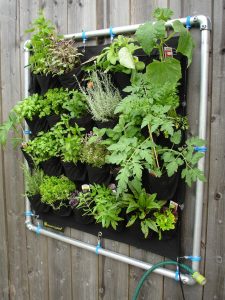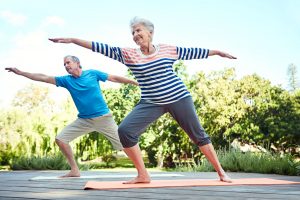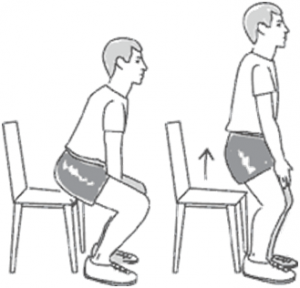6 simple exercises that can keep you feeling young & healthy as you age

Even if you’re not overweight and don’t suffer from any serious medical conditions, it’s critical that you exercise regularly. It not only helps prevent chronic health conditions, but also can keep you feeling young and energetic.
In addition, it helps you maintain the strength and mobility needed to remain in your own home and age in place safely. It can even help ease arthritis pain and stiffness.
Still, it can be difficult to exercise — either because you don’t feel you have the time or you suffer from a physical ailment that keeps you from getting out and doing what you love.
What comes first?
The first key to getting regular exercise? Setting time aside to do it.
Even just getting your heart pumping for a few minutes per day can have a dramatic effect on your health. Put “exercise” on your calendar and make a commitment to do it. Once you establish an exercise routine, it becomes easier to get the exercise your body needs.
What comes second?
The second key to getting regular exercise? Finding activities you can do safely.
To help, here’s a list of six activities just about anyone can do safely in and around their own home to help keep them feeling young and healthy.
Note: It’s always a good idea to consult your doctor before beginning any exercise regimen. If you plan to incorporate any of these exercises, discuss them with your doctor to make sure they don’t conflict with any medical conditions you have.
 1. Gardening
1. Gardening
The first activity on the list, gardening, has multiple benefits:
- It gets you outside in the fresh air.
- It gets you on your feet and walking around.
- It gets you to use your hands, which can help with arthritis.
- It can help you eat healthier — if you have a green thumb for planting fruits and vegetables.
One common problem: When most people think of gardening, the first image that pops into their heads is getting on their hands and knees, and digging in the dirt. For seniors with back pain or knee problems, this seems like a daunting task.
 But gardening doesn’t have to take place in the ground. Think about getting hanging planters or finding someone who can build inexpensive planter boxes for you at waist height.
But gardening doesn’t have to take place in the ground. Think about getting hanging planters or finding someone who can build inexpensive planter boxes for you at waist height.
Don’t know a handyman? Check out all of the waist-high table garden options available on Amazon. Even if you don’t purchase one of these, they’re a great source of ideas.
2. Dancing
Grab a loved one — or even a grandchild — turn on some music, and get dancing. You don’t have to go to a club, senior center or social gathering to get moving to music.
You can do it in your own home. Remove any trip-and-fall hazards from your living or family room, and you’ve got the perfect dance floor.
Bonus: It’s a great opportunity to introduce your grandkids to the music you loved growing up.
3. Stretching

Most people don’t think of stretching as exercising, but it is — and it’s great for you. It can keep you nimble and help you avoid injuries from activities like lifting, shoveling, running, walking and much more.
Stretching can also improve your comfort level when sitting for long periods, traveling or playing with the grandkids, as it prevents you from getting stiff.
Some keys to stretching:
- Warm up. A brief five-minute walk can get your muscles, joints, tendons and heart ready for light stretching.
- Breathe. As with any exercise, it’s important to remember to keep breathing.
- Don’t force it. While stretching, you should never feel pain. That’s a sign you’ve gone too far.
Here is a great list of stretches (with photos) from the National Institute on Aging.
4. Walking
Some seniors think they do enough walking if they’re getting out of the house and going to the store. But that may not be the case. Chances are, you’re really not walking all that much.
As a result, it can be important to make sure you set time aside to go for a walk around your neighborhood or local park. Going on a purposeful walk will keep your heart rate up longer than just walking around a store where you’ll be stopping and resting a lot.
Want to ramp up your walk? Invite one of your grandkids to walk with you. This will help ensure you keep your pace up. Is your grandchild not interested in going for a walk? Ask around the neighborhood to see if someone has a dog they’d be willing to let you walk (just make sure the dog isn’t too big and doesn’t pull on the leash too much). This could be the perfect motivator to get a grandchild to join you.
5. Squatting
If you’re beginning to have trouble getting up from chairs on your own, it could pay to do some light squatting exercises.

To begin, stand in front of a sturdy chair. Keep your arms in front of you and begin to squat toward a seated position. Be careful not to let your knees extend past your toes. Hold the position for a few seconds, then come back up. Do this 10 times, rest and then do it 10 times again (two sets of 10 reps with a rest in between). Hold onto the chair if the exercise is too challenging.
6. Wall push-ups
Traditional push-ups (on the floor) are a great way to build and maintain strength in your arms, shoulders and chest. But as you age, they can become harder to do.
When laying on the floor is no longer an option, try wall push-ups.
Stand facing a wall, about arms-length away. Press the palms of your hands flat against the wall and lean forward, slowly inching your upper body toward the wall (don’t move your feet). Then, push yourself away from the wall (simulating a push up) and repeat 10 times, rest and then do 10 more “push-ups.”
This, too, will help you build and maintain strength in your arms, chest and shoulders.
Want more?
If you’re interested in learning more exercises — ones that can be tailored to your own specific health and capabilities — contact a Friends Life Care Coordinator. They’ll get to know you, your needs and your goals, and help establish a wellness, exercise and care plan that can help you age in place.
Leave a Comment
